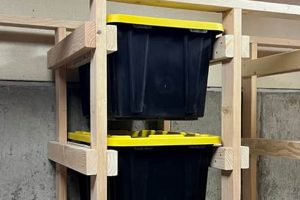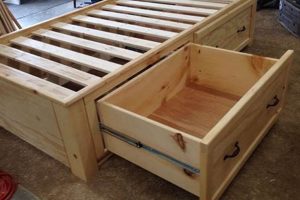Creating personalized organizational solutions for vertical surfaces within a dwelling is a practice characterized by resourcefulness and customization. This involves utilizing available materials and skill to construct shelves, containers, or other fixtures directly affixed to walls for the purpose of storing diverse items. For instance, repurposing reclaimed wood to build floating shelves in a living room demonstrates the application of this technique.
The significance of this approach lies in its capacity to maximize limited spatial resources, particularly within smaller living environments. Historically, the concept of adapting and modifying existing structures to suit individual needs has been prevalent across diverse cultures. By offering a cost-effective and adaptable alternative to pre-fabricated storage units, this strategy empowers individuals to tailor their living spaces according to specific organizational requirements while reflecting personal aesthetic preferences.
The subsequent sections will delve into the practical considerations for undertaking such projects, exploring design principles, material selection criteria, and step-by-step construction methodologies relevant to creating effective and aesthetically pleasing solutions for wall-mounted organization.
DIY Wall Storage
Effective implementation of wall-mounted organizational structures requires meticulous planning and precise execution. The following guidelines aim to enhance the durability, functionality, and aesthetic integration of such projects within residential spaces.
Tip 1: Assess Load-Bearing Capacity: Prior to installation, determine the wall type (e.g., drywall, plaster, brick) and its inherent structural limitations. Employ appropriate anchors and fasteners rated to support the anticipated weight of stored items. Neglecting this step may result in structural failure and potential damage.
Tip 2: Prioritize Accurate Measurement: Precise measurements are crucial for ensuring level and properly aligned installations. Utilize a level and measuring tape to accurately determine shelf placement and spacing. Inaccurate measurements can lead to instability and aesthetic imperfections.
Tip 3: Select Appropriate Materials: Material selection should be based on both aesthetic preferences and functional requirements. Consider the durability, moisture resistance, and weight capacity of various materials such as wood, metal, and composite boards. Choose materials that complement the existing dcor and withstand the intended usage.
Tip 4: Implement Secure Fastening Techniques: Employ appropriate screws, anchors, and construction adhesives to ensure secure attachment to the wall. For heavier items, consider using wall studs for added support. Confirm that fasteners are properly sized for the chosen materials and wall type.
Tip 5: Optimize Vertical Space Utilization: Design organizational structures that maximize vertical space by incorporating adjustable shelves, hooks, or containers. This approach enhances storage capacity and promotes efficient utilization of available wall area.
Tip 6: Conceal Hardware Effectively: Strive to conceal mounting hardware such as screws and brackets to create a clean and aesthetically pleasing appearance. Utilize countersinking techniques, decorative covers, or recessed mounting systems to minimize visual intrusion.
Tip 7: Consider Accessibility and Ergonomics: Position shelves and storage containers at a comfortable and accessible height. Ensure that frequently used items are easily reachable without requiring excessive stretching or bending. This promotes user convenience and minimizes the risk of strain or injury.
These recommendations underscore the importance of careful planning, precise execution, and attention to detail when constructing wall-mounted organizational solutions. Adherence to these principles will contribute to the creation of functional, durable, and aesthetically integrated storage systems.
The concluding section will offer insights on personalization and styling strategies to seamlessly integrate these organizational elements into the overall design scheme.
1. Spatial Optimization
Spatial optimization, in the context of “diy wall storage,” denotes the strategic allocation of resources within a limited area to maximize storage capacity and usability. The inherent constraint of available floor space frequently necessitates vertical expansion; therefore, effective implementation of “diy wall storage” becomes a critical method for achieving this optimization. The correlation is causal: restricted floor area prompts the need for wall-mounted solutions, while the success of these solutions directly influences the overall spatial efficiency of the environment.
The significance of spatial optimization within “diy wall storage” lies in its ability to transform previously underutilized vertical surfaces into functional storage zones. For instance, consider a small urban apartment. Without strategically placed wall shelves, available space is quickly consumed by ground-level clutter. Introducing a system of custom-built shelves, cabinets, or hanging organizers efficiently utilizes the vertical dimension, liberating valuable floor space. This not only enhances the aesthetic appeal of the apartment but also improves its overall functionality and habitability. Further, consider the utilization of otherwise dead spaces such as the areas above doorways, or the insides of cabinet doors, which become prime targets for spatial optimization.
Understanding the principles of spatial optimization is practically significant for anyone undertaking “diy wall storage” projects. It necessitates a thorough assessment of current storage needs, an evaluation of available wall space, and the careful selection of appropriate materials and designs. A well-planned system, informed by the principles of spatial optimization, will not only provide adequate storage but also contribute to a more organized, efficient, and aesthetically pleasing living environment. Challenges in achieving effective spatial optimization may include structural limitations of walls, aesthetic preferences, and budget constraints, all of which must be carefully considered during the planning phase. Successfully navigating these challenges will yield benefits far exceeding the initial investment of time and resources.
2. Material Selection
Material selection constitutes a pivotal phase within the “diy wall storage” development process. The performance, longevity, and aesthetic coherence of the storage solution are directly contingent upon the careful consideration and selection of appropriate construction materials.
- Structural Integrity
The chosen material must possess adequate structural integrity to bear the intended load. Solid wood, for instance, provides superior strength compared to particleboard, making it suitable for heavier items. The selection should align with the anticipated weight and distribution to prevent structural failure. For example, using thin plywood for a bookshelf intended to hold heavy textbooks would be inadvisable due to its limited load-bearing capacity.
- Environmental Compatibility
Environmental factors within the installation location necessitate careful material selection. In humid environments, moisture-resistant materials like treated lumber or certain plastics are preferable to prevent warping, mold growth, or degradation. Utilizing untreated wood in a bathroom, for example, could lead to premature decay and structural compromise.
- Aesthetic Integration
The selected material should complement the existing interior design scheme. The texture, color, and finish of the chosen material impact the visual harmony of the storage solution within the surrounding environment. Employing reclaimed wood for a rustic-themed living room or using sleek metal shelving in a modern, minimalist space exemplifies aesthetic integration considerations.
- Workability and Cost-Effectiveness
The ease with which a material can be worked and manipulated significantly affects the complexity and cost of the “diy wall storage” project. Materials that are easy to cut, drill, and fasten are often preferred for beginner-level projects. Balancing cost with durability and aesthetic appeal is essential; a lower-cost material that compromises longevity or visual appeal may ultimately prove to be a less effective choice.
The interplay between these facets underscores the critical role of informed material selection in “diy wall storage.” The optimal choice balances structural requirements, environmental considerations, aesthetic preferences, and practical construction limitations, resulting in a storage solution that is both functional and visually appealing.
3. Secure Installation
Secure installation is paramount to the successful and safe implementation of any “diy wall storage” solution. The stability and longevity of these projects hinge upon adherence to proper installation techniques, ensuring that the storage unit can reliably support its intended load without posing a risk of detachment or structural failure.
- Anchor Selection and Compatibility
The choice of wall anchors must be compatible with both the wall material (e.g., drywall, plaster, concrete) and the anticipated weight. Inadequate anchor selection can lead to pull-out failure, causing the entire storage unit to collapse. For example, using lightweight plastic anchors in drywall to support a heavy bookshelf is a common and potentially dangerous error. Employing toggle bolts or molly bolts in drywall or using masonry anchors in concrete ensures a more secure and reliable connection.
- Stud Engagement and Load Distribution
Whenever possible, fastening directly into wall studs is the preferred method for securing wall-mounted storage. Studs provide significantly greater load-bearing capacity compared to drywall or plaster alone. Proper stud finding techniques and the use of appropriate screws are essential. If stud engagement is not feasible, distributing the load across multiple anchor points can help mitigate the risk of localized stress and failure. An example might be a floating shelf system that utilizes multiple anchors along its length to distribute the weight of items placed upon it.
- Leveling and Alignment
Precise leveling and alignment are crucial for both aesthetic and structural reasons. An unlevel installation places uneven stress on the fasteners and can compromise the overall stability of the storage unit. Using a level during installation ensures that the unit is properly aligned, distributing the weight evenly and preventing undue stress on individual components. Misaligned components can also cause doors and drawers to bind or function improperly, reducing the usability of the storage solution.
- Fastener Tightening and Verification
Proper tightening of fasteners is essential to ensure a secure connection between the storage unit and the wall. Overtightening can strip screws or damage anchors, while undertightening can leave the connection vulnerable to loosening over time. Regularly verifying the tightness of fasteners, particularly in areas subject to vibration or movement, is a prudent maintenance practice. Using appropriate torque settings when using power tools can help prevent overtightening and ensure a consistent and reliable connection.
These facets of secure installation collectively contribute to the reliability and safety of “diy wall storage” projects. Failure to adequately address these considerations can result in property damage, personal injury, and the premature failure of the storage solution. Therefore, a thorough understanding of these principles is essential for anyone undertaking a “diy wall storage” project.
4. Load Distribution
Load distribution, within the context of “diy wall storage,” refers to the method by which the weight of stored items is dispersed across the supporting structure and its attachment points to the wall. Improper load distribution is a primary cause of structural failure in “diy wall storage” installations, leading to potential property damage and personal injury. Therefore, effective load distribution is not merely a best practice but a fundamental requirement for safe and reliable wall-mounted storage solutions.
The importance of load distribution stems from the limited weight-bearing capacity of wall materials, particularly drywall and plaster. Concentrated loads placed upon inadequately supported areas can exceed these limits, resulting in drywall anchors pulling through the wall or studs experiencing excessive stress. For example, a long shelf supporting a collection of heavy books must have sufficient support along its entire length, either through multiple stud attachments or strategically placed support brackets, to prevent sagging or detachment. Similarly, a wall-mounted cabinet containing fragile items requires secure and evenly distributed anchoring to mitigate the effects of vibration or accidental impacts.
Understanding the principles of load distribution has practical significance for those undertaking “diy wall storage” projects. It necessitates a thorough evaluation of the anticipated weight of stored items, the type and spacing of wall supports (studs or anchors), and the structural integrity of the chosen materials. Failure to account for load distribution introduces significant risk. Conversely, a carefully planned and executed installation, considering these factors, ensures the stability and longevity of the storage solution. Successfully achieving proper load distribution, by incorporating principles such as maximizing stud engagement and using appropriate anchor types for the anticipated load, minimizes the risk of failure and maximizes the usability of the “diy wall storage” project.
5. Accessibility Design
Accessibility design, in the context of “diy wall storage,” considers the ease with which individuals of varying physical abilities can interact with and utilize the storage solutions. It directly addresses the spatial configuration and usability of wall-mounted units, ensuring inclusivity for users with mobility limitations, visual impairments, or other physical challenges. The cause-and-effect relationship is clear: neglect of accessibility design in “diy wall storage” results in reduced usability and potential safety hazards for a significant portion of the population, while its inclusion fosters independence and convenience for all users. Accessibility Design’s significance lies in promoting equitable access to storage, maximizing the functionality for everyone, and potentially mitigating risks, specifically related to reaching or navigating a confined space.
The practical applications of accessibility design principles within “diy wall storage” are diverse. For individuals using wheelchairs, the height of shelves and cabinets becomes critical. Lower placement, generally between 15 and 48 inches from the floor, ensures independent reach and retrieval of stored items. Furthermore, the depth of shelving is also significant. Shallower shelves prevent the need for excessive reaching, reducing strain and improving accessibility. For users with visual impairments, tactile labeling and high-contrast color schemes can enhance the identification of stored items. Implementing pull-down shelves or lift systems can be very valuable in areas with high reach shelves. These mechanisms bring items down to an accessible level, reducing the risk of falls. Clear floor space around storage units, often overlooked, is also crucial for maneuverability. Real life implications are for any public space or living space that can be used by people with disabilities.
In conclusion, integrating accessibility design into “diy wall storage” is not merely a consideration but a fundamental aspect of responsible design. By prioritizing inclusivity and usability, “diy wall storage” solutions become more effective, safer, and contribute to creating more accommodating and functional environments for all users. Neglecting accessibility poses barriers for individuals, while incorporating its principles enhances independence, safety, and overall user satisfaction. The challenges lies in understanding the range of diverse users requirements and to keep on updating building practices to the needs of the population.
Frequently Asked Questions
This section addresses common queries regarding the planning, construction, and implementation of “diy wall storage” solutions. The information provided aims to clarify potential uncertainties and facilitate informed decision-making.
Question 1: What are the primary factors influencing the structural integrity of wall-mounted shelving?
The structural integrity is primarily determined by the wall material, anchor selection, material of the shelf itself, and the weight distribution. Understanding the load-bearing capacity of the wall and utilizing appropriate anchors are paramount. The type of wood, its thickness, and the spacing of supports also contribute significantly.
Question 2: How does one accurately assess the weight capacity of drywall anchors?
The weight capacity is typically indicated on the anchor packaging. However, it is crucial to consider that these ratings are often based on ideal conditions. It is advisable to derate the stated capacity by a safety factor, and distribute the load across multiple anchors whenever possible. Overestimation of weight capacity is a common cause of failure.
Question 3: What are the key considerations when selecting materials for wall-mounted storage in a bathroom environment?
Moisture resistance is the primary consideration. Materials prone to water damage, such as untreated particleboard, are unsuitable. Treated lumber, certain plastics, or sealed wood products are better choices. Proper ventilation of the bathroom is also essential to minimize moisture exposure.
Question 4: What techniques can be employed to conceal mounting hardware for a cleaner aesthetic?
Countersinking screws and using wood filler to conceal screw heads are common methods. Decorative caps or covers designed to fit over screws or brackets can also be utilized. Recessed mounting systems, where the hardware is hidden behind the shelving unit, offer a more seamless appearance.
Question 5: How can one ensure that a wall-mounted shelf is perfectly level during installation?
A spirit level or laser level is essential. Mark the desired shelf position using a pencil and level, then use these marks as a guide for attaching the shelf supports. Regularly check the level throughout the installation process to ensure accurate alignment.
Question 6: What steps can be taken to prevent stored items from sliding off wall-mounted shelves?
Implementing shelf lips or rails along the edge of the shelf can provide a physical barrier. Using non-slip shelf liners or mats can increase friction and prevent items from shifting. Additionally, strategically positioning larger or heavier items to brace smaller items can help maintain stability.
These FAQs offer a starting point for understanding the complexities of “diy wall storage.” Careful planning and attention to detail are essential for achieving safe, functional, and aesthetically pleasing results.
The subsequent section will explore advanced techniques and design strategies for maximizing the potential of wall-mounted storage solutions.
Conclusion
This exploration of “diy wall storage” has underscored the critical aspects of planning, construction, and implementation. Key points encompassed structural integrity, material selection, secure installation, load distribution, and accessibility design. The successful application of these principles dictates the functionality, safety, and longevity of wall-mounted organizational systems.
Effective utilization of vertical space represents a significant advantage in contemporary living environments. Prioritizing informed decision-making and meticulous execution will result in optimized storage solutions that enhance spatial efficiency and aesthetic value. Continued adherence to best practices and ongoing evaluation of emerging technologies will further refine the art of “diy wall storage”, promoting innovation and adaptability in meeting evolving storage demands.







![Build Your Own! Storage Bin Rack DIY Project [Easy] The DIY Hub: Creative Crafts, Repairs & Life Hacks Build Your Own! Storage Bin Rack DIY Project [Easy] | The DIY Hub: Creative Crafts, Repairs & Life Hacks](https://craftingdiycenter.com/wp-content/uploads/2025/07/th-1825-300x200.jpg)